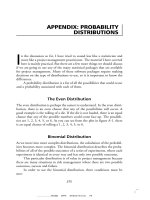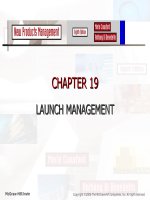New Products Management- CHAPTER 20 PUBLIC POLICY ISSUES potx
Bạn đang xem bản rút gọn của tài liệu. Xem và tải ngay bản đầy đủ của tài liệu tại đây (370.76 KB, 16 trang )
CHAPTER 20
CHAPTER 20
PUBLIC POLICY ISSUES
PUBLIC POLICY ISSUES
McGraw-Hill/Irwin
Copyright ©2006 The McGraw-Hill Companies, Inc. All right reserved.
Life Cycle of a Public Concern
Life Cycle of a Public Concern
Stirring
Trial Support
Political Arena
Regulatory Adjustment
Figure 20.1
Product Liability: Typology of Injury
Product Liability: Typology of Injury
Sources
Sources
Inherent Risk in Product
Design Defects
Dangerous Condition
No Safety Device
Inadequate Materials
Defects in Manufacture
Inadequate Instructions or Warnings
Dangers After Use
Four Legal Bases for Product Liability
Four Legal Bases for Product Liability
Negligence
Manufacturer let the product be injurious
Warranty
A promise
Express warranty: a statement of fact
about a product
Implied warranty: arises when product is
made available for a given use
Four Legal Bases for Product Liability
Four Legal Bases for Product Liability
(continued)
(continued)
Strict Liability
Seller is responsible for not putting a
defective product on the market
Defenses: assumption of risk;
unforeseeable misuse; not defective
Misrepresentation
Implied use of product, even if not
defective
Other Legislation
Consumer Product Safety Act/Safety Commission
Which Are the Real Product Warning
Which Are the Real Product Warning
Labels?
Labels?
1. On a disposable razor: “Do not use this product during an earthquake.”
2. On a rock garden: “Eating rocks may lead to broken teeth.”
3. On a roll of Life Savers: “Not for use as a flotation device.”
4. On a hair dryer: “Do not use while sleeping.”
5. On a piano: “Harmful or fatal if swallowed.”
6. On a cardboard windshield sun shade: “Warning: Do not drive with sun shield in
place.”
7. On shin guards: “Shin guards cannot protect any part of the body they do not
cover.”
8. On syrup of ipecac: “Caution: may induce vomiting.”
9. On an iron: “Do not iron clothes while being worn.”
10. On a plastic sled: “Not to be eaten or burned.”
11. On work gloves: “For best results, do not leave at crime scene.”
12. On a jet ski: “Riders may suffer injury due to forceful entry of water into body
cavities while falling off this craft.”
13. On a carpenter’s router: “This product not intended for use as a dentist’s drill.”
14. On a blender: “Not for use as an aquarium.”
15. On a stroller: "Always remove child from stroller before folding."
Figure 20.4
Which Are the Real Product Warning
Which Are the Real Product Warning
Labels?
Labels?
1. NO
2. On a rock garden: “Eating rocks may lead to broken teeth.”
3. NO
4. On a hair dryer: “Do not use while sleeping.”
5. NO
6. On a cardboard windshield sun shade: “Warning: Do not drive with sun shield in
place.”
7. On shin guards: “Shin guards cannot protect any part of the body they do not cover.”
8. NO
9. On an iron: “Do not iron clothes while being worn.”
10. On a plastic sled: “Not to be eaten or burned.”
11. NO
12. On a jet ski: “Riders may suffer injury due to forceful entry of water into body
cavities while falling off this craft.”
13. On a carpenter’s router: “This product not intended for use as a dentist’s drill.”
14. NO
15. On a stroller: "Always remove child from stroller before folding.“
Figure 20.4
Preparing For the Product Recall
Preparing For the Product Recall
Prior to the Recall
Designate the recall program coordinator
(spokesperson)
Develop channels for communicating with customers
directly
During the Recall
Assess safety risk and take corrective action
Inform customers as well as intermediaries of the risks
After the Recall
Strive to restore company reputation
Monitor recall effectiveness
Public Policy Problems and the New
Public Policy Problems and the New
Products Process
Products Process
Figure 20.6
Other Areas of Public Policy Debate
Other Areas of Public Policy Debate
Environmental Needs
Product Piracy
Worthy Products
Morality
Monopoly
Personal Ethics (what would you do?)
Environmental Needs
Environmental Needs
A new product is said to hurt the environment if:
Its raw materials are scarce or hard to get to.
Its design or manufacture causes pollution or excess
power usage.
Its use causes pollution.
Its disposal cannot be handled by recycling.
Some companies test market their products in
Germany and Scandinavia, because of the strict
greenness tests there.
Product Piracy
Product Piracy
Threatens brand equity and intellectual property of
firms.
Categories of product piracy:
Counterfeiting: unauthorized production of goods
Brand Piracy: unauthorized use of copyrights or patented
brands (the “$20 Rolex”)
Near Brand Usage: slightly different brand names (“Tonny
Hilfiger” clothes)
Intellectual Property Copying: Unauthorized copying of CDs
and DVDs, for example
Protection Against Product Piracy
Protection Against Product Piracy
Communication
Legal recourse
Government
Direct contact
Labeling
Strong proactive marketing
Piracy as Promotion
Figure 20.7
Source: Laurence Jacobs, A. Coksun Samli, and Tom Jedlik, “The Nightmare of International Product Piracy,”
Industrial Marketing Management
30, 2001, pp. 499-509.
Worthy Products
Worthy Products
Coffee manufacturers agreed to produce some
brands containing no beans from El Salvador.
Manufacturers have been asked to produce
special exercise equipment for the handicapped
or modified products for the elderly.
Orphan drugs supported by the federal
government; otherwise would not be
commercially feasible due to few users.
Personal Ethics – What Would You
Personal Ethics – What Would You
Do?
Do?
1. You introduce a temporary product and are told not to let distributors or your
sales force know it is only temporary and will soon be replaced.
2. You are marketing a new seminar service to train bank personnel in investment
counseling, but you don’t know they will really learn how to counsel.
3. You are working on an item to be sold to virtually every K-12 school. You
calculate gross margin at about 80%. The price could be cut in half and your
company margin would still be 60%.
4. Your database service collects patient records from physicians and offers a new
service of information for pharmaceutical firms, including patients’ name, age,
sex, and so on, as well as illnesses and treatments.
5. Your company’s “educational” game cards are known to be bought by less
sophisticated parents: there are several far better games on the market.
6. Your brewing company markets a new beer containing legal (sterilized) hemp
seeds, mostly as a gimmick. Nevertheless, your advertising contains obvious
drug imagery.
What Can the New Product Manager
What Can the New Product Manager
Do?
Do?
Include in Strategy and Policy
Consider public policy implications in PIC
Control Systems
Product Testing
Marketing Prepares Warnings/Labels
Adequate Market Testing (to identify
miscommunications)
Education (to company personnel and customers)
External Affairs









